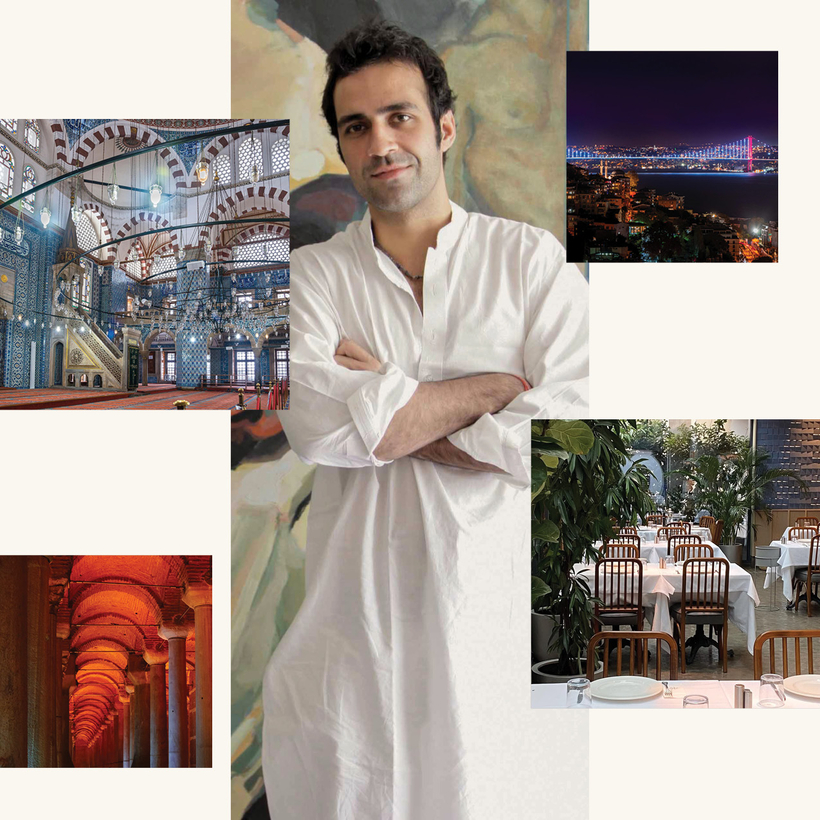The writer Aatish Taseer has always lived between cultures. His mother, Tavleen Singh, is Indian and a journalist; his father, Salmaan Taseer, was the former Pakistani governor of Punjab, assassinated in 2011 by his bodyguard. Born in London and raised in New Delhi, Taseer had his Indian citizenship revoked in 2019, following his Time magazine story titled “India’s Divider in Chief,” where he criticized Prime Minister Narendra Modi.
In his new essay collection, A Return to Self: Excursions in Exile, he travels through Istanbul and Uzbekistan, reflects on the legacy of Buddhism, and considers what it means to seek belonging in a globalized world, especially in the wake of the pandemic. Here, Taseer shares his guide to Istanbul, a city he’s described as one of “competing identities,” and, fittingly, the place where his journey began.

KARAKÖY LOKANTASI
The Cipriani of Istanbul, with a dazzling array of mezze and wonderful people-watching. It’s an absolute classic. Plan a long lunch over cold globes of Turkish white wine. (karakoylokantasi.com)
ZENNUP1844
It would take a lot for me to recommend a dry restaurant to anyone, but this miracle of an establishment, with its focus on Anatolian food, is worth an afternoon of teetotaling. There is a lamb shank from Afyon, with traditional clotted-cream keşkek (a stew of meat and grain), that I still dream of. (instagram.com)
ARTER
This marvelous contemporary art museum was the brainchild of my friend, the collector and industrialist Omër Koç. The ultra-modern building, in a historic neighborhood, displays super innovative art, producing a kind of historical synesthesia, almost as if Istanbul’s many centuries were collapsing into a single moment. (arter.org)

BASILICA CISTERN
Istanbul is a palimpsest of classical buildings, with layers of historical accretion, but nothing fills me with a childish wonder more intense than this underground palace of columns, where you might stumble upon an upside-down Medusa head casting a reflection in the dark water. (instagram.com)
FIRUZAĞA BATH
Istanbul is a city of hamams, but I have a special attachment to this somewhat disreputable establishment. It was here, when still closeted, that I came to terms with being gay. A Return to Self has one essay that deals in part with the thrill, playfulness, and sensual pleasure of sexual awakening in Istanbul.
HAGIA SOPHIA
It had to be there. Once a church, then a mosque, then a historical site and now, under Erdogan, a mosque again, this is one of those buildings that is the architectural equivalent of Marcel Mauss’s total social fact. Read it like a book and it will reveal to you the many selves of this schizophrenic city of cities.

RUSTEM PASHA MOSQUE
My favorite of the great Ottoman architect Mimar Sinan’s many triumphs in Istanbul is this jewel of a mosque with an interior of exquisite blue tiles, with arches picked out in burnt umber. It’s beautifully proportioned, allowing you to contemplate Sinan’s genius in a space relatively free of the crowds that throng his more famous creations.
THE MUSEUM OF INNOCENCE
I don’t love Orhan Pamuk—I find his work dense and unreadable—but he has written one book, The Museum of Innocence, for which I will be forever in his debt. This utterly wacky museum in Cihangir displays artifacts from Pamuk’s masterpiece. (masumiyetmuzesi.org)
Princes’ Islands
There are few things more exhilarating than taking a flying catamaran down the Bosporus to these nine marvelous islands that form a small archipelago. They’re full of delightful restaurants, such as Prinkipo Meyhanesi Fıstık Ahmet, and old hotels like the Splendid Palace on Büyükada, the largest of the islands.

THE BOSPORUS
This stunning waterway of Homeric blue that divides Asia from Europe is the most wonderful thing about Istanbul. Try to be on it as much as possible, visiting places such as Ortaköy, Arnavutköy, Bebek, and Rumeli Hisarı. Then walk along the heavenly strait to Iskele for fresh fish.
Yeniköy
This neighborhood is where I lived as a 25-year-old, and every Sunday we would go to a fish restaurant here. The one I used to go (Aleko) has deteriorated, but it’s worth making the trip to Kıyı in Tarabya.
